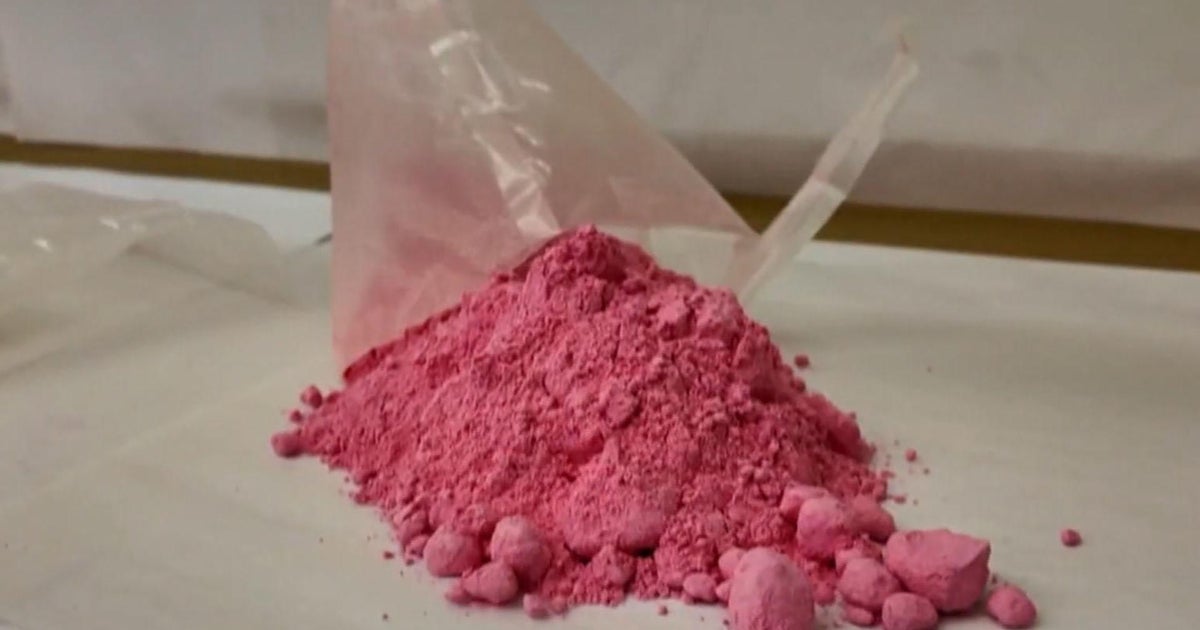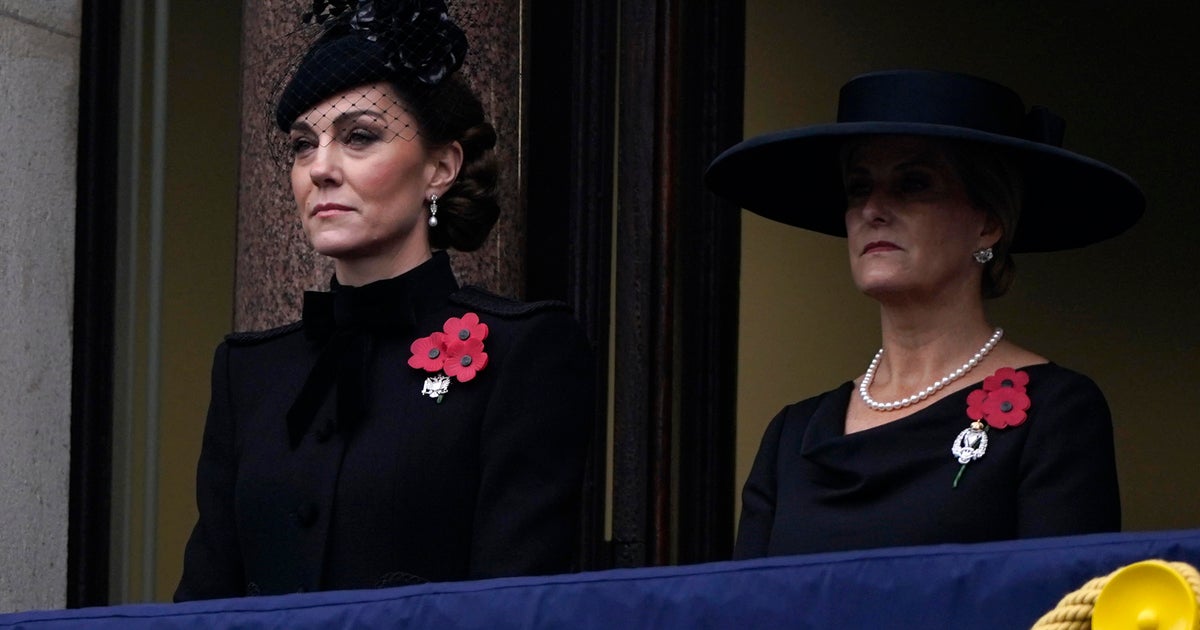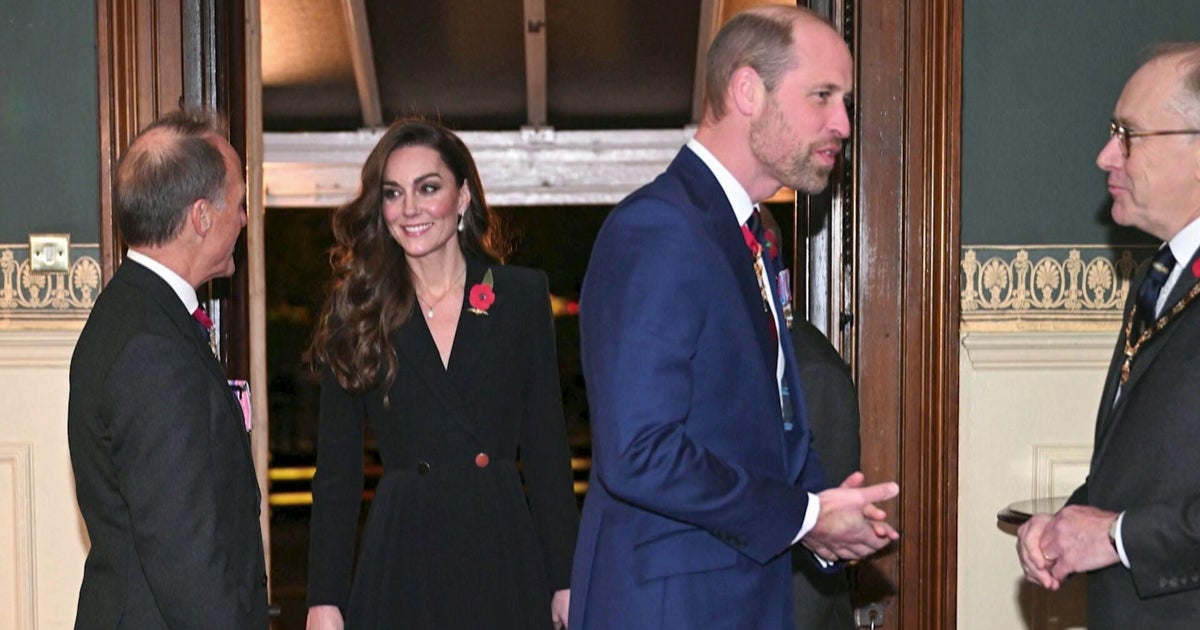CBS News
Watch Princess Kate’s video statement revealing her cancer diagnosis

Catherine, the Princess of Wales, revealed in a video statement Friday she has been diagnosed with cancer, calling the news a “huge shock.” In the message, which you can watch above, Kate said the unspecified type of cancer was detected after she underwent major abdominal surgery in January and she is currently undergoing chemotherapy.
Kate said that after the surgery in London, doctors thought her condition was non-cancerous and the operation was a success, but ensuing tests showed that cancer was present.
“My medical team therefore advised that I should undergo a course of preventative chemotherapy and I am now in the early stages of that treatment,” she said.
In the video message recorded on Wednesday and broadcast Friday, Kate asked for “time, space and privacy” while she recovers.
“This of course came as a huge shock, and William and I have been doing everything we can to process and manage this privately for the sake of our young family,” Kate said in the video message. “As you can imagine, this has taken time. It has taken me time to recover from major surgery in order to start my treatment. But, most importantly, it has taken us time to explain everything to George, Charlotte and Louis in a way that is appropriate for them, and to reassure them that I am going to be ok.”
Sitting on a garden bench and wearing a striped sweater, Kate said that she is “getting stronger every day by focusing on the things that will help me heal; in my mind, body and spirits.” She added that she her husband, Prince William, had been comforting her.
/ AP
“Having William by my side is a great source of comfort and reassurance too. As is the love, support and kindness that has been shown by so many of you. It means so much to us both.”
Kate’s video message comes after growing public speculation over her health, fueled in part by at least two doctored images that were released in recent days. Kate, 42, hadn’t been seen publicly since Christmas until a short video surfaced this week of her and William walking outside a farm shop.
Kate said in the video released Friday that she would focus on making a full recovery.
“My work has always brought me a deep sense of joy and I look forward to being back when I am able, but for now I must focus on making a full recovery. At this time, I am also thinking of all those whose lives have been affected by cancer. For everyone facing this disease, in whatever form, please do not lose faith or hope. You are not alone.”
Kensington Palace said the video message was filmed by BBC Studios in Windsor on Wednesday.
CBS News
Recall affects roughly 240,000 electric vehicles

Watch CBS News
Be the first to know
Get browser notifications for breaking news, live events, and exclusive reporting.
CBS News
Law enforcement raises warning over so-called pink cocaine

Watch CBS News
Be the first to know
Get browser notifications for breaking news, live events, and exclusive reporting.
CBS News
Lowriders shine in New Mexico after perceptions of the cars and their drivers shift

The Merriam Webster dictionary defines lowrider as “a customized car with a chassis that has been lowered so that it narrowly clears the ground.” Lowrider also is used to describe the person driving such a vehicle, and both car and driver have long been potent cultural symbols, especially among Mexican Americans.
In the 1980s and ’90s, many cities passed “anti-cruising” ordinances, because police departments and the public often saw lowriders as menacing; connected to drugs and gangs.
It’s taken decades, but that perception is finally changing, And nowhere is the transformation more pronounced than in the lowrider hotbed of northern New Mexico.
Eppie Martinez: So the ride will be a little bit rough.
Bill Whitaker: That’s OK.
Eppie Martinez: That’s what hydraulics is, it’s– you know–
Bill Whitaker: But– but we look cool.
Eppie Martinez: Yeah, yeah, yeah, yeah, (laugh)
On Good Friday 2024, we’re cruising down Riverside Drive in Española, New Mexico with Eppie Martinez and his family in his 1953 Chevy Bel Air- his pride and joy.
60 Minutes
Eppie Martinez: You gotta have your siren (turns siren on)
Bill Whitaker: Gotta have your siren.
He’s been cruising this road in this vintage car since he was a kid with his dad at the wheel. And Good Friday has long been the day for local lowriders.
Eppie Martinez: This is the grand opening of spring, you know? Everybody looks forward, as you can see today. Oh, my God, it’s gonna be–
Bill Whitaker: It’ll blow my mind.
Eppie Martinez: Definitely.
Martinez is leading a candy-colored caravan of cars from his Viejitos Car Club – that’s “old men” in Spanish. Espanola calls itself the “lowrider capital of the world,” and on Good Friday the Viejitos were joined by lowriders from many other local car clubs for a chrome-and-tailfin celebration of their culture. Some were shining up and staying put to be admired, while others showed off the crazy hydraulic gymnastics lowriders are known for.
Among New Mexico’s lowriders, Eppie Martinez is known as the man who makes cars do that.
Bill Whitaker: So people come to you–
Eppie Martinez: Yes, yes.
Bill Whitaker: –to have the hydraulics put in their cars?
Eppie Martinez: Yes. Yes, yes, exactly. Yeah, exactly.
Bill Whitaker: How many have you done?
Eppie Martinez: Oh, I’ve done over 500 probably. (laugh)
The hydraulics in his own precious ’53 Bel Air are fairly modest.
Eppie Martinez: We got ourselves here something not too much. I got a two pump setup. It’s mostly aircraft.
Bill Whitaker: This is aircraft technology?
Eppie Martinez: Exactly.
Bill Whitaker: In this old car.
Eppie Martinez: Exactly.
Those hydraulic pumps, designed to operate aircraft flaps and landing gear, are controlled by switches at the driver’s seat.
Eppie Martinez: So that’s really– that’s all it really does. It doesn’t go too much, ’cause, you know, I don’t wanna hurt it. You know what I mean?
Bill Whitaker: Yeah.
Over the years, Martinez has installed hydraulics that seem guaranteed to hurt cars, turning them into what lowriders call hoppers that drew competitors and crowds to this Espanola parking lot on Good Friday, to see who could jump highest.
60 Minutes
Whether they hopped to the sky or sat ever-so-low to the ground, each lowrider we saw that day seemed to say “here I am!”
Delubina Montoya: It’s an expression of who you are. So it’s kind of an extension of your personality.
Delubina and Eric Montoya were there with their 1947 Chevrolet Fleetmaster convertible.
Delubina Montoya: It’s sleek. It’s classic. It’s beautiful. It’s kinda me. (laughter)
Eric Montoya: It’s round. It’s shapey. It’s shiny.
Delubina Montoya: So, see, it’s me. (laughter)
Patricia Trujillo: Lowriders are all about that, right? They’re– the car amongst cars. They’re gonna be the one that pops.
Patricia Trujillo is an Espanola native, a college professor, and deputy cabinet secretary of New Mexico’s Department of Higher Education. She told us the roots of the lowrider culture here stretch back to just after World War II.
Patricia Trujillo: You had many– Mexican Americans going into the Army, and then coming back and still being treated as second-class citizens. And so– a lot of those—people basically created this counter-culture to be able to speak back and say, “We belong here, too. “It’s almost like a saunter or a swagger in vehicle form, right?
Bill Whitaker: It’s sort of like embracing the Americanness, the car culture, but making it your own and saying, “I am part of America, but I’m not part of this mainstream. I am doing my own thing here.”
Patricia Trujillo: Yeah. And we ARE our own thing.
Bill Whitaker: So low and slow, instead of fast and furious?
Patricia Trujillo: Yes, absolutely.
These are Buicks and Pontiacs and Chevys from the glory days of Detroit…
…customized with elaborate interiors, intricate engraving, and kaleidoscopic colors in the paint jobs. The over-the-top style isn’t for everyone, but these cars are all labors of love, whether do-it-yourself jobs or those restored by professionals for tens of thousands of dollars.
Rob Vanderslice: This ends up about 100 coats of material when it’s all said and done.
60 Minutes
Bill Whitaker: 100 coats of paint.
Rob Vanderslice: 100 coats of paint.
Rob Vanderslice is a legendary painter from Albuquerque, and a rare “gringo” in New Mexico’s lowrider world.
Rob Vanderslice: Why not utilize the tape, so you end up with a nice little point through the middle?
…famous for using tape and spray paint to lay down layers of different colors, as he demonstrates in weekly YouTube tutorials.
Rob Vanderslice: We’re talkin’ hours and hours. And it just is a beautiful breakup of, like, a darker orange, a medium orange, and then a light orange. It’s kinda a fan of colors.
Vanderslice started painting lowriders in the late 1980s. That’s just about when gangster rap artists popularized the cars in music videos. That contributed to a public impression of lowriders as connected to gangs and drugs.
Bill Whitaker: Back in the day, were most of your clients involved with gangs and drugs?
Rob Vanderslice: Back then, I did a car for just about every gang you could think, you know what I mean?
Vanderslice himself had a years-long addiction to crystal meth while he was making a name for himself painting all those cars.
Bill Whitaker: Congratulations on– on being clean.
Rob Vanderslice: Thank you. Thank you–
Bill Whitaker: How long? How long have you–
Rob Vanderslice: Thirteen years clean now–
Bill Whitaker: And how’d you do it?
Rob Vanderslice: Got in trouble. I’m a three-time convicted felon. And– the last time I just said, “You know what? I’m done.”
His personal rehabilitation parallels the path traveled by New Mexico’s lowriders. counter-culture rebels, turned gangsters, now steadily rolling into the mainstream.
Bill Whitaker: So you have gone from painting cars for gangs to painting cars for the Albuquerque Police Department.
Rob Vanderslice: Right. Right.
Bill Whitaker: That’s a big leap.
Rob Vanderslice: Yeah, that’s a huge leap.
In the lowriders’ leap, Patricia Trujillo remembers a particular pivot.
Patricia Trujillo: In the Plaza in Santa Fe, lowriding had been banned for many years.
60 Minutes
Santa Fe is the capital of New Mexico and its artistic center, so when the city’s mayor not only dropped the ban on cruising but declared a “Lowrider Day” in 2016, Trujillo says cars slow-rolled in by the hundreds.
Patricia Trujillo: There was this real shift in culture in that moment of recognizing– lowriders as an important part of our heritage, an important part of the artistry– of our communities. And I really feel like that marked a new moment in New Mexico.
Joan Medina: So we’re all a family.
Joan and Arthur Medina – everyone calls him “Low Low” – personify the morphing of lowriders’ image in the Espanola Valley. She was in junior high school when they met more than 40 years ago.
Joan Medina: As we were driving into Espanola, I’m like, “Oh, my gosh, look at that car.” And then I was like, “Look at the guy in it.” I told my aunt.
Bill Whitaker: Was his car better than everybody else’s car?
Joan Medina: We don’t like to compete–
Bill Whitaker: Ahh, OK.
Joan Medina: –with people, but (whispers) Yeah!
Bill Whitaker: It stood out more.
Joan Medina: –it stood out more, a lot more. You could see it for miles.
That car is still in a makeshift museum full of lowriders outside their home, with a few in the yard awaiting makeovers. Low Low’s “masterpiece” – covered front, back, and sides with murals depicting the life of Jesus – was being re-painted the day we were there.
Bill Whitaker: Is your– is your car an– a– making a statement?
Joan Medina: Yes.
Arthur Medina: Yes.
Bill Whitaker: W– what’s that statement?
Arthur Medina: It’s our f– it’s our fishing net.
Joan Medina: Wherever we take our cars, people are drawn to his artwork, people are drawn to what we’ve done to the cars and who we are, and people know us from all over.
Bill Whitaker: So it draws people in.
Joan Medina: It draws people.
60 Minutes
But if drawing attention was once the only goal, they’re now using that attention to help kids and serve their community.
Bill Whitaker: Words now, we’re saying family, community, faith. In the past, words associated with lowriders were “gangs,” “drugs,” and “crime.”
Joan Medina: Yes, it’s very true.
Bill Whitaker: What changed?
Joan Medina: I think what changed in a big way, is that we started– being out more in the community, to kind of volunteer.
Arthur Medina: –we’re always here to encourage, we’re always here to help.
Joan Medina: We saw a need for the homeless. And I said, “OK, let’s do a coat drive and a clothing drive.” Man, (clap) we got five huge truckloads of jackets and clothes and shoes.
Bill Whitaker: Is it almost as simple as the original lowriders– have just grown out of their rebellious ways?
Patricia Trujillo: I wouldn’t say they’ve grown out of rebellion. I think that they’ve redefined it, right?
Bill Whitaker: What’s the definition of rebellion now?
Patricia Trujillo: Rebellion now– is healing. To be that beacon of hope, right?
Espanola needs hope. With rates of poverty, crime and drug addiction well above state and national averages, despair is part of the landscape.
Ben Sandoval: A lot of our kids are from broken homes.
Ben Sandoval is director of the YMCA teen center in Espanola.
60 Minutes
Ben Sandoval: There’s drugs. There’s bad influences. What we try to do through the teen center is to provide them a safe place.
In 2023, Sandoval got a grant from the DEA – yes, the Drug Enforcement Administration – for a project to build lowrider bicycles.
Bill Whitaker: How does that help with the at-risk kids?
Ben Sandoval: First of all, it gives ’em an opportunity to say, “Hey, I gotta get to the teen center after school every Wednesday.” They have to feel that they’re valued in their role as the engineer, as the designer, as the planner —
Ben Sandoval: They do it all.
The finished bikes were so creative, so impressive, the prestigious museum of Spanish Colonial Art in Santa Fe mounted a special exhibition to put them on display!
Bill Whitaker: It really is quite beautiful art.
Ben Sandoval: Thank you–
Bill Whitaker: These kids have created.
Ben Sandoval: It’s remarkable. It was just this vibrant buzz of happiness in the room during the opening.
Bill Whitaker: Yeah. The kids hadn’t seen ’em like this before–
Ben Sandoval: No. Never. And I’d sit back with three or four youth, and I say, “Look at that. They’re– they’re taking pictures of YOUR bike. That’s what YOU did.”
Car shows now feature lowrider bicycles, with trophies for the best. Same for kids with radio-controlled cars that tilt and bounce. And the fanciest car shows rival any museum display.
Patricia Trujillo: Now when you see– cruises, it literally can feel like a– moving art exhibit, right, as you’re watching it go by.
Bill Whitaker: A moving art exhibit?
Patricia Trujillo: Yes.
Bill Whitaker: That’s pretty good.
Joan Medina’s artwork is a glittering grand prix. She and Low Low loved showing it off for us, on an afternoon cruise in the hills above Espanola.
Low Low Medina: All cars have a different style when you’re cruisin’ ’em
Bill Whitaker: This one, I have to say, is eye-catching.
Joan Medina: Thank you. That’s what I wanted.
Produced by Rome Hartman. Associate producers, Sara Kuzmarov and Matthew Riley. Broadcast associate, Mariah B. Campbell. Edited by Michael Mongulla.















